If it were said that the industry is producing some hot bikes right now, then UK cycle company Whyte is positively scorching. Their latest range of trail and enduro bikes are scooping up international awards hand over fist and their T-130 RS trail bike picked up our Design & Innovation Award 2016 for it’s impeccable trail handling. Whyte have now released a carbon version, the T-130 C, which has exploded over the UK bike media and is being heralded as the perfect trail bike – it’s time to see what all the fuss is about.
Update May 2016: We’ve also had the Whyte T-130C RS in our trail bike group test.
The Whyte T-130 C RS
The 130 mm travel Whyte T-130 C sits comfortably with the latest generation of ultra-capable trail bikes, packing aggressive geometry into a lightweight (12.45 kg without pedals for our size Medium) form. With versatility at its core, the T-130 C is as a bike to do everything, from railing smooth arcs on buff trail centre singletrack to taking on big mountain epic rides. Visually, Whyte has done a great job, using a uni-directional carbon front triangle and aluminium rear triangle, Whyte has really gone to town with the styling, embracing the flexibility of carbon to produce a very beautiful bike. The internal routeing keeps the look clean and we like the very neat internal integrated seat post bolt which results in a smooth and seamless junction between post and frame. Riders who ‘go year round’ will love that all the bearings have weatherproof covers and carry a lifetime warranty should the water get in.
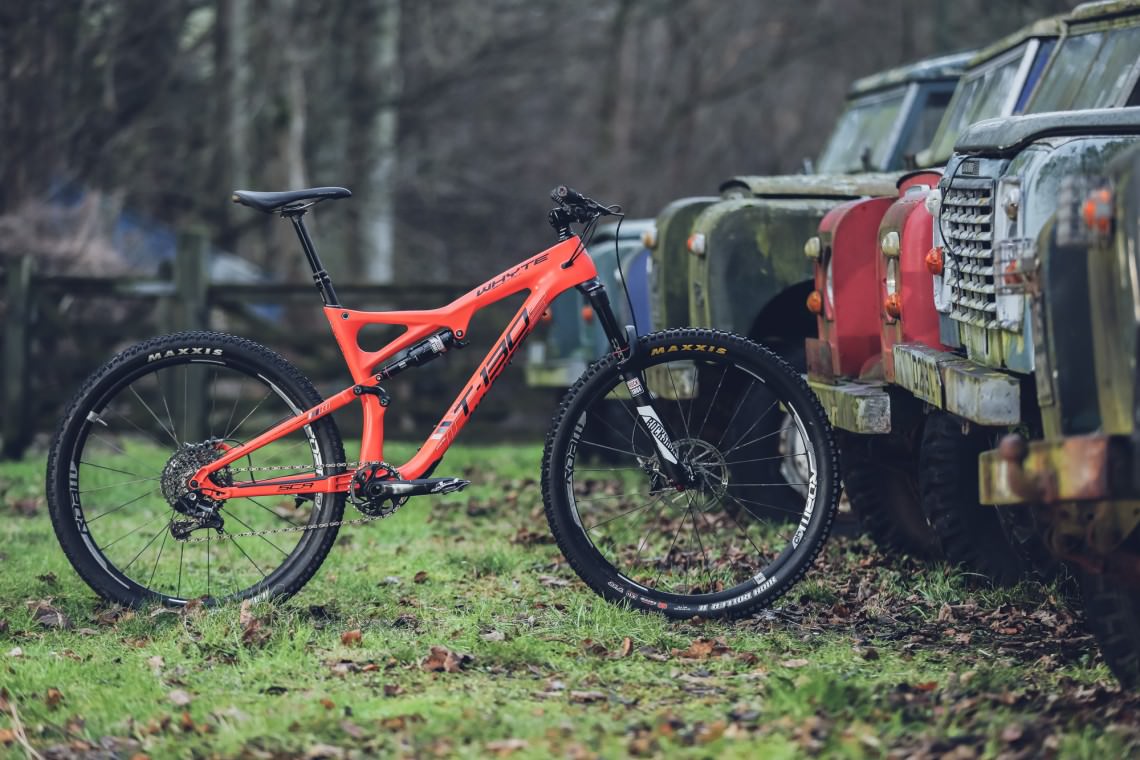
Whyte’s Single Ring Specific design
Whyte was one of the first companies to embrace the benefits of design possible with 1x drivetrains. Removing provision for a front mech has allowed Whyte to pull the chainstays right into 420 mm and seriously beef up the rear triangle and pivots. Whyte have also used the new Boost standard to again stiffen the union between wheel and frame.
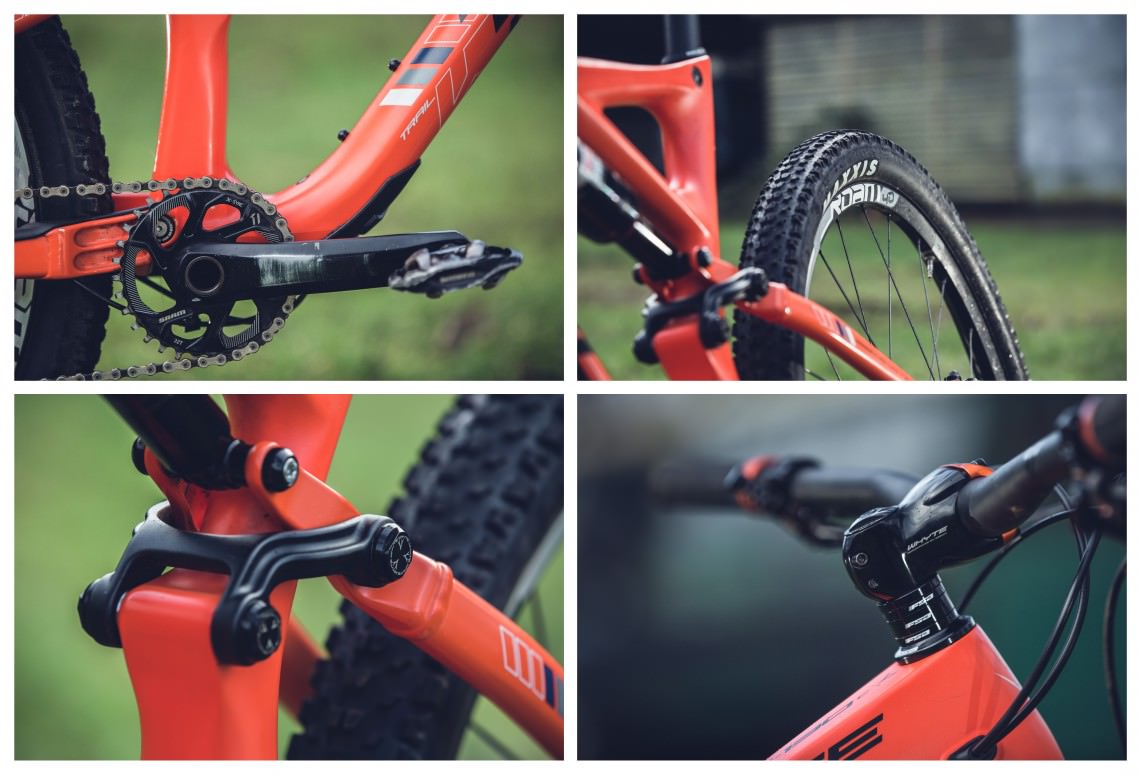
Geometry of the Whyte T-130 C
The geometry of the new T-130 C is bang up to date and is aggressive without being too extreme. A 67-degree head angle hits that sweet spot between engaging handling and confidence in rough terrain while avoiding steering like a barge at low speeds. When it comes to sizing the T-130 C is a long bike (449mm reach in Medium) so those with short backs should think carefully or demo before sizing up. The 331 mm bottom bracket height is aggressively low reinforcing the bikes aggressive intentions.
| Size | M | L | XL |
|---|---|---|---|
| Head Tube Angle | 67° | 67° | 67° |
| Seat Tube Angle | 73.5° | 73.3° | 73.2° |
| Top Tube | 611.1 mm | 631.0 mm | 650.7 mm |
| Head Tube Length | 115 mm | 120 mm | 130 mm |
| Seat Tube Length | 431.8 mm | 457.2 mm | 482.6 mm |
| BB Height | 331.0 mm | 331.0 mm | 331.0 mm |
| Chain Stay Length | 420 mm | 420 mm | 420 mm |
| Wheelbase | 1156.5 mm | 1176.5 mm | 1196.5 mm |
| Stack | 589 mm | 594 mm | 603 mm |
| Reach | 449 mm | 467 mm | 483 mm |
Specification of the Whyte T-130 C RS
For €4500 (£3499) the specifications of the RS model (a more expensive Works model is available for €5750, £4499 with a Fox 34 Factory Float FIT4 Fork, Whyte Carbon wheels and a Shimano XT drivetrain with Raceface carbon crank), leaves little to be desired. The bike rolls on SRAMs latest 27.5 Roam 40 rims, offering a 21 mm internal width, which is a bit skinny by today’s standards, and UST compatibility. The 1615 g rims proved durable during our testing, and were surprisingly stiff for a trail wheelset; this feeling may have been in part caused by the very solid Boost rear end. The 1×11 drivetrain draws mainly from the SRAM X1 groupset, with a highlight X0 rear mech, the X1 chainset is fitted with an XSYNC 32T chainring for good chain retention. Purposefully, as mentioned, there’s no provision for a front mech, but when the retention and gear range of the X1 is so good, we cannot imagine any reason why you would want one.
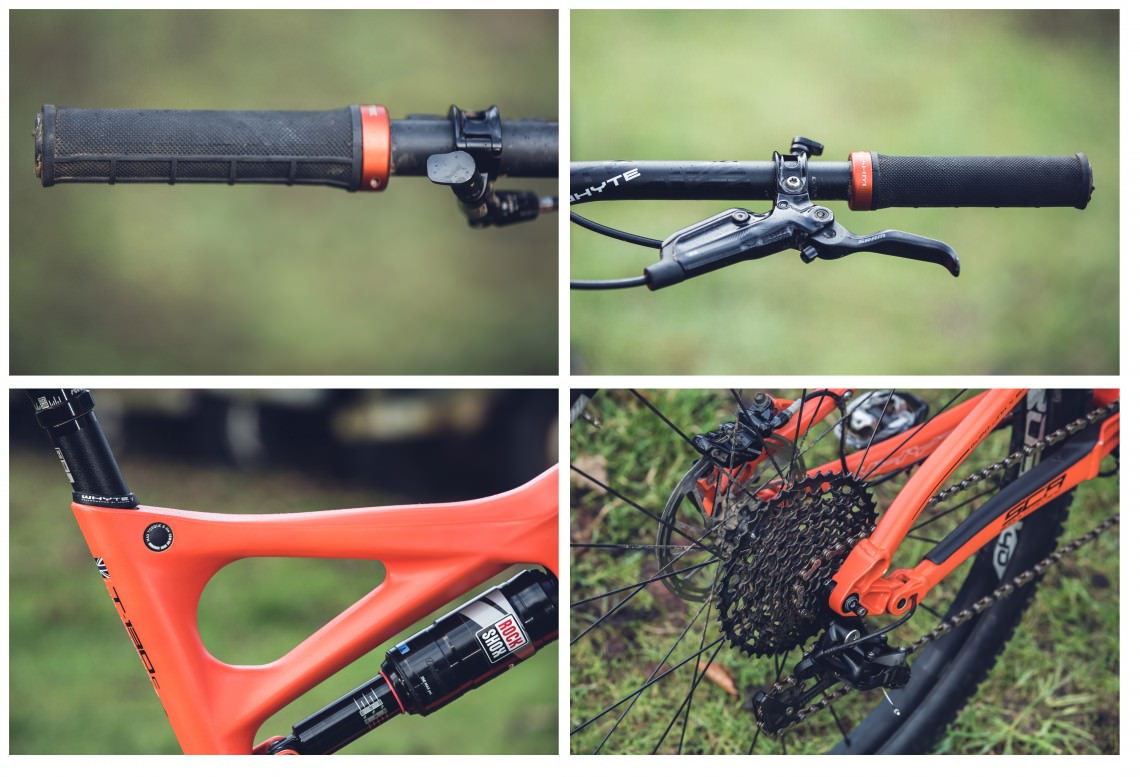
When it comes to the cockpit, Whyte is right on point for a hard-charging trail blaster, choosing their own brand 40 mm stem in the size Small and 50 mm stems in the rest of the sizes. Combined with their own brand 760 mm bars the cockpit is instantly familiar and well-suited to the bikes intent. We are happy to see the remote for the 125 mm drop reverb is slung underneath the bar out of harm’s way on the left, leaving an uncluttered and functional cockpit. The ‘no-nonsense-do-anything’ build kit is finished with some SRAM Guide RS brakes which haul down the speed well, although they did insist on merrily singing the “Guide Brake” song in the wet.
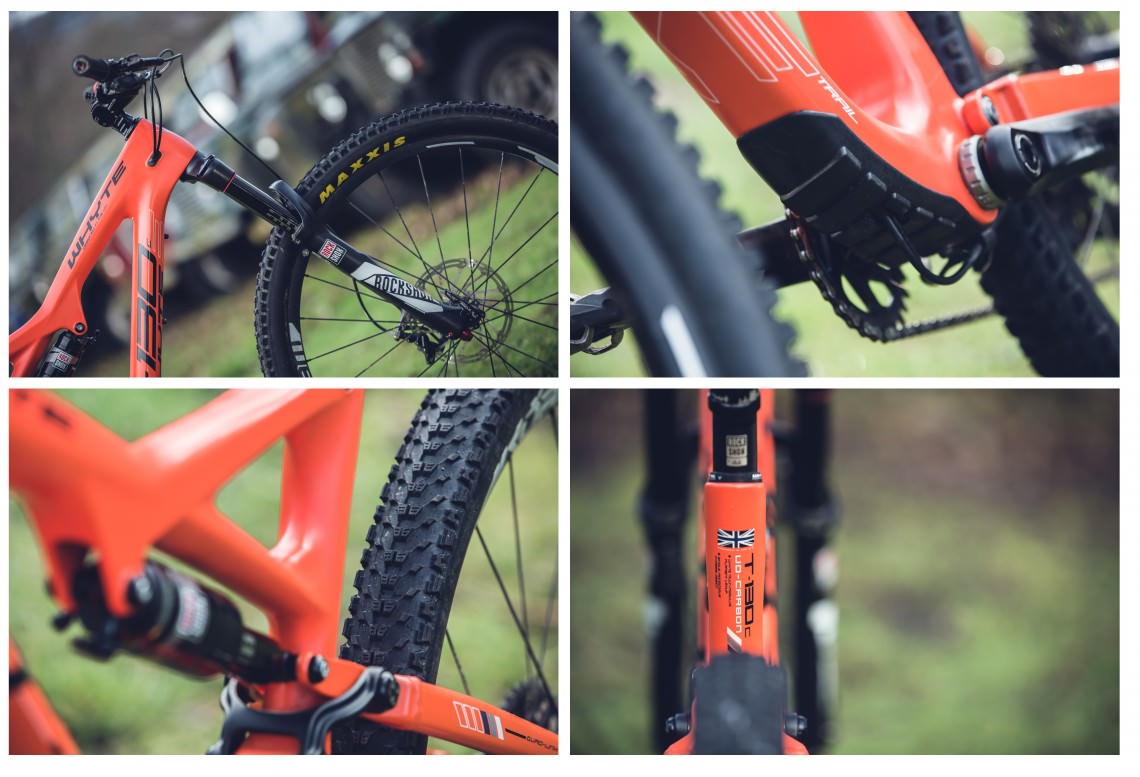
Climbing on the Whyte T-130 C RS
We tested the Whyte T-130 C on all manner of terrain, from long XC mountain rides, jump parks, trail-centre-night-ride blasts, multi-day trips and plenty of hard charging down EWS stages. The versatility of the bike made it the first choice for testers when faced with a full day out on the pedals. We suspected that the Whyte would be a good climber, and indeed, it fired up the hills with vigour and excitement. The 67-degree head angle kept the steering precise when spinning up steep technical climbs, and the combination of a firm shock tune and stiff rear triangle ensure that all power translates to forward speed. The 73.5-degree seat angle is middle-of-the-road, but the climbing position felt good, the long front triangle and short rear end gave the impression that you are sitting further back in the bike, but progress was very efficient and we didn’t experience any loss of traction up short punchy climbs. We found it was always one of the first bikes to the top of the hill on group rides, but how would it’s lightweight construction and short travel handle on the descents?
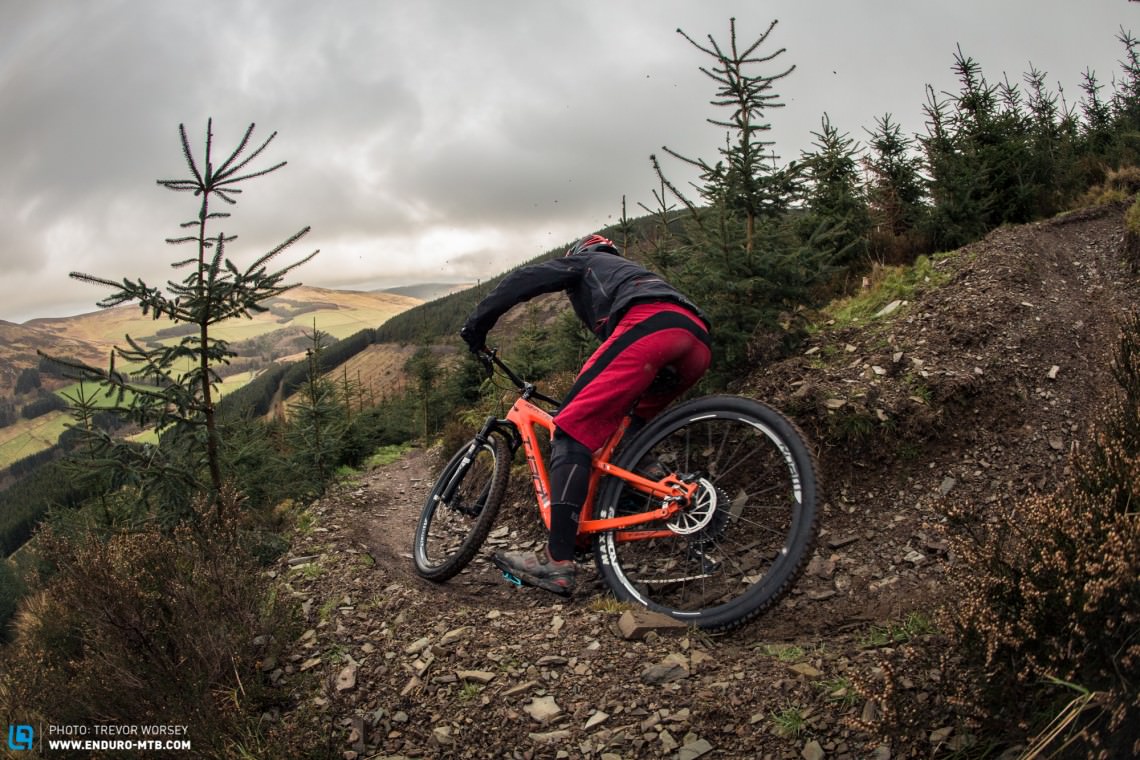
Descending on the Whyte T-130 C RS
On smooth, flowing trails we found that the Whyte is insanely fast, the punchy power delivery and low and composed geometry means that super high speeds feel fun, secure and intuitive. The medium compression / fast rebound tuned Rockshox Monarch Debonair shock is very well paired to the frame, providing a ride that is taught and progressive without any wallow or sluggishness to the stroke. The QUAD-4 suspension never gives up too much travel, it’s no plush bouncer, more a muscular greyhound of a bike. The handling is razor sharp without feeling nervous and late braking and tail slides can be encouraged easily. The supportive suspension means lifting the bike into the air is effortless, and even the most ground hugging riders will be looking for opportunities to double up every section.

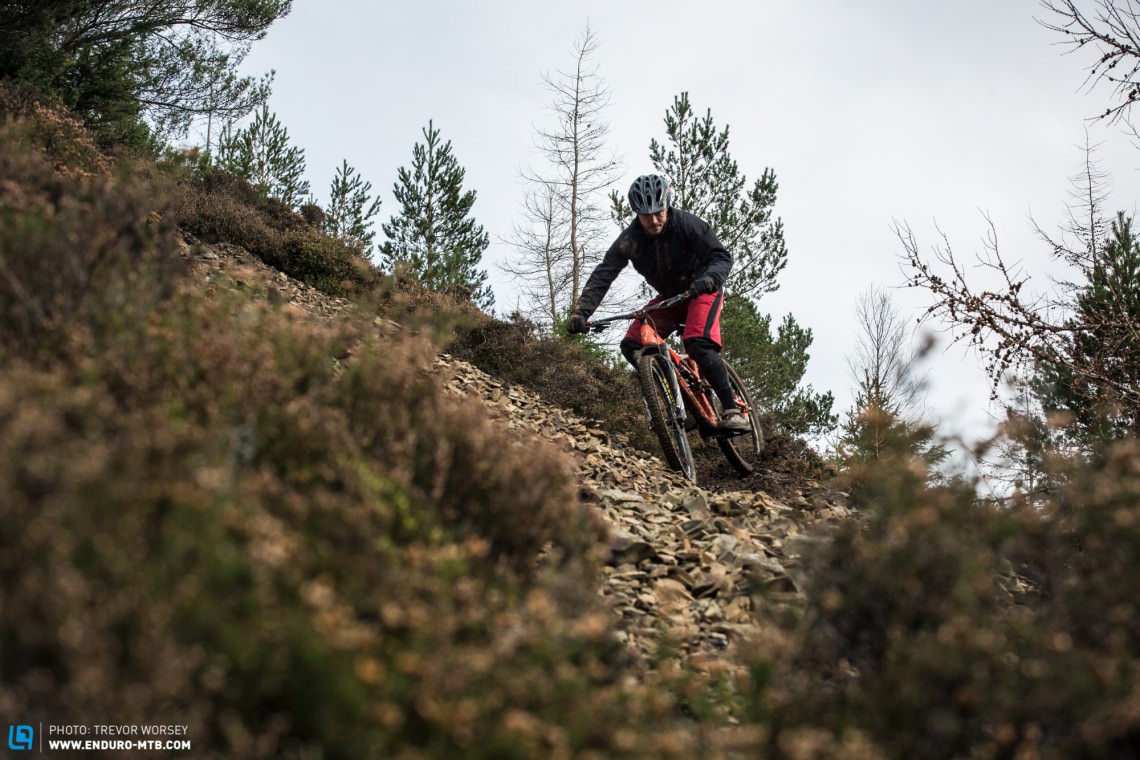
While the well-balanced suspension means the Whyte corners effortlessly, where it excels is out of the corners, short bursts of effort are rewarded with brutal acceleration. Brake-rail-sprint-repeat! High-speed progress on the Whyte is intoxicatingly fun and even the laziest of testers were hitting everything full gas, reeling in riders in front a meter at a time. For fun trail riding the T-130 C is among the very best.
But could it go further? As testament to the bikes poise and confidence, we found ourselves drifting more frequently in terrain that would push a big 160 mm bike, and surprisingly had a great time! When pushing hard on rocky terrain chasing the fastest enduro bikes, the shorter 130 mm of travel and feather weight makes their presence felt, running out of travel on violent repeated hard hits. However, the well-tuned shock ramps up well keeping the bike from hanging up, and the long wheelbase feels stable and in its element. When a bike is on the limit, good geometry becomes everything and this is where the T-130 C plays its trump card. It’s long top tube and aggressive angles combined with the powerful Rockshox Pike fork mean that in the hands of a confident rider it charges hard on terrain where it really shouldn’t be able to, happy to go toe to toe with much longer travel machines.

Is the T-130 C the ultimate trail bike?
When it comes to finding fault with the T-130 C there is very little to complain about, the ride, performance and specification is all outstanding. For the testing, we switched out the rear tyre to a Maxxis Highroller II (over the fast rolling Maxxis Ardent) which instantly opened up the bikes potential in the winter grime. We did also notice that we were starting to see heel rubbing on the wide boost dropouts damaging the paint, unfortunately, this a problem that plagues a lot of Boost 148 mm bikes, and we would certainly recommend applying some frame protection here. But that’s it, a very short list after a month of riding!

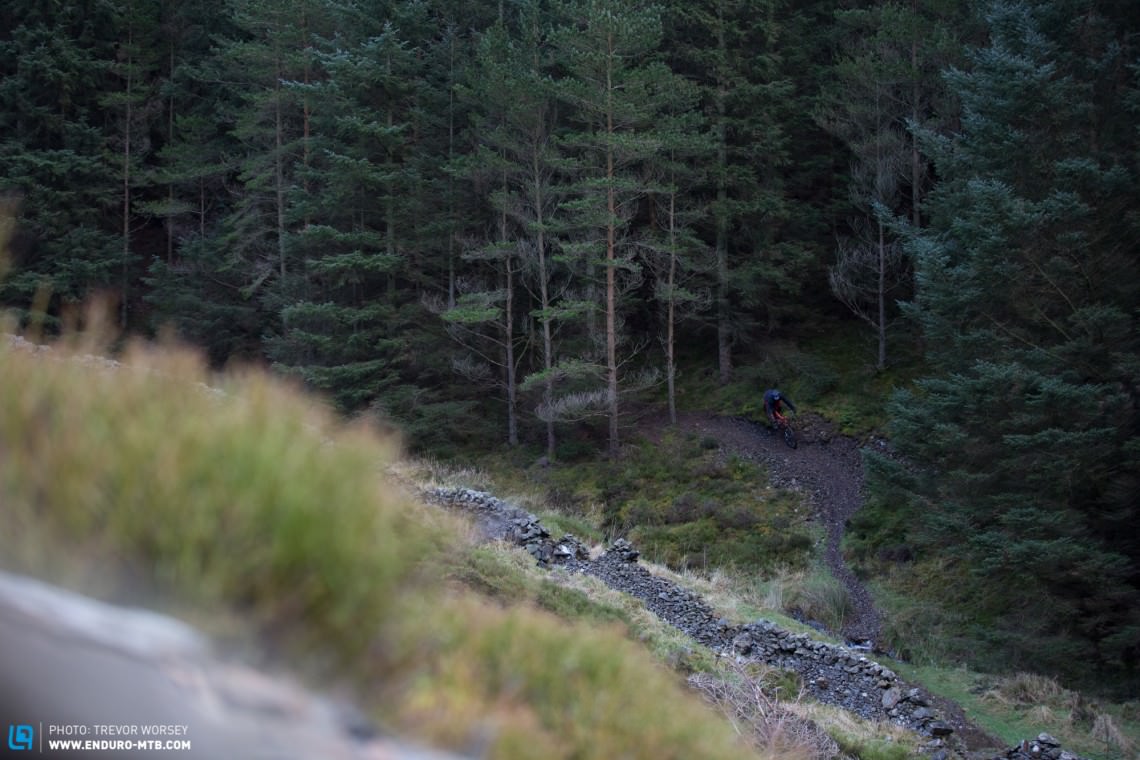
So in conclusion, the T-130 C will be lots of things to lots of people. For an intermediate rider, the long and highly capable geometry will inspire confidence on steep terrain, and the easy to exploit playfulness will see previously nervous riders taking to the air at every opportunity. Those who have been dragging round a longer travel beast will love the spirited climbing and will find themselves first to the top of the hill, before slaying the downs. More advanced riders will find the excellent shock tune and geometry make the T-130 C a furiously fast, agile and potent trail weapon, easy to exploit and able to stay with much longer travel bikes when the going gets rough.
Bottom Line
The Whyte T-130 C takes everything that makes the aluminum T-130 great but packages it in a lighter and more aggressive form. Out of the box, it’s a blisteringly fast trail bike with exceptional handling and poise, performing exceptionally well on terrain where a 130 mm travel bike should struggle. Is the T-130 C a brilliant trail bike? Yes, it is, and one that is so capable that it made us question why we would ever need more travel?
For more information on Whyte bikes you can find out more on their website.
Update May 2016: We’ve also had the Whyte T-130C RS in our trail bike group test.
Words and photos: Trev Worsey
Did you enjoy this article? If so, we would be stoked if you decide to support us with a monthly contribution. By becoming a supporter of ENDURO, you will help secure a sustainable future for high-quality mountain bike journalism. Click here to learn more.








